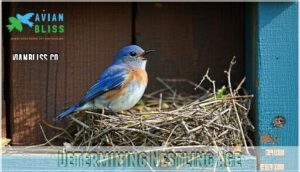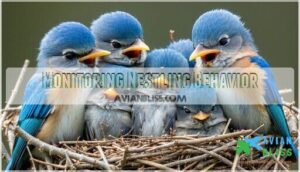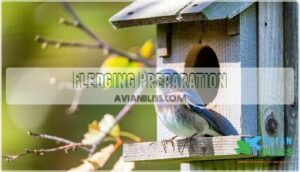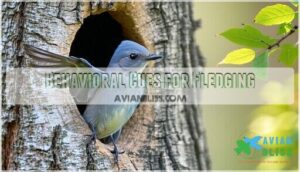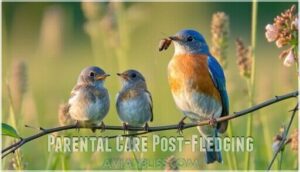This site is supported by our readers. We may earn a commission, at no cost to you, if you purchase through links.
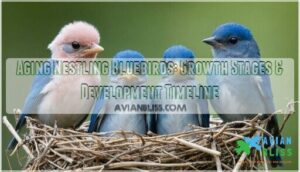
Day-old hatchlings are pink, featherless, and weigh just 2 grams, while 5-day-old nestlings open their eyes and begin sprouting pin feathers.
By day 10, you’ll notice dark blue wing feathers emerging, and 15-day-old birds show nearly complete feather coverage.
Weight increases from 2 to 18 grams over three weeks, following a steady growth curve.
Pin feather emergence, eye opening timing, and size comparisons provide the most reliable aging methods for these cavity nesters during their 16-21 day nest period.
Understanding these precise timing patterns reveals fascinating insights about ideal monitoring schedules.
Table Of Contents
- Key Takeaways
- Age of Bluebird Nestlings
- Determining Nestling Age
- Nestling Growth Characteristics
- Tools for Age Estimation
- Nestling Development Stages
- Monitoring Nestling Behavior
- Fledging Preparation
- Behavioral Cues for Fledging
- Ensuring Fledgling Safety
- Parental Care Post-Fledging
- Frequently Asked Questions (FAQs)
- How long does it take for baby bluebirds to mature?
- What is the survival rate of fledgling bluebirds?
- Where do baby bluebirds go after fledging?
- What age are baby bluebirds ready?
- What is the survival rate of baby bluebirds?
- How do you know when baby bluebirds are ready to leave the nest?
- How do you save a baby blue bird?
- How to attract bluebirds to nest boxes?
- What materials are best for building nests?
- How to prevent predators from accessing nests?
- Conclusion
Key Takeaways
- You’ll age nestling bluebirds most accurately by tracking weight gain from 2 to 18 grams and measuring pin feather emergence between days 6-8, as these provide reliable developmental markers within half-day precision.
- You can determine fledging readiness by watching for behavioral cues like restlessness, cavity peeking, and wing-stretching exercises that typically appear around days 16-20 when nestlings are fully feathered.
- You’ll need to combine multiple aging methods—weight charts, morphometric measurements (tarsus length, culmen size), and visual developmental stages—rather than relying on single indicators for accurate age estimation.
- You should time your monitoring carefully to avoid disturbing near-fledging nestlings, as premature fledging reduces survival rates during the critical post-nest period when only 50% survive their first year.
Age of Bluebird Nestlings
Since you’ve asked for help aging nestling bluebirds, you’ll need to understand their rapid development timeline. Nestling Weight and Feather Growth serve as your best indicators for Bird Age Estimation.
During the first week, hatchlings gain weight quickly while their eyes remain closed. By day five, Nestling Development Stages become more distinct as pin feathers emerge.
Bluebird Development accelerates through the second week when eyes open and feathers unfurl. Proper Nestling Care requires knowing these Aging Nestling Bluebirds techniques to determine Fledging Timing accurately.
Understanding Nestling Age helps you provide appropriate monitoring without disturbing their natural growth patterns. This knowledge of bluebird parental care is essential for identifying the specific needs of nestlings at different stages.
Determining Nestling Age
Precision matters when aging nestling bluebirds.
Morphometrics provide the most accurate bird age determination through weight charts and measurement-based aging models.
You can measure mass, tarsus length, and culmen size to predict age within half a day using validated equations.
Precise morphometric measurements unlock nestling age secrets with remarkable accuracy.
Mass-based models work best for nestling age estimation up to 10 days, while culmen measurements extend accuracy to 15 days.
These development stages markers eliminate guesswork in bird age estimation, helping you track feather growth progress systematically without repeated disturbance that risks premature fledging.
For accurate age estimation, nest box monitors can refer to nestling growth charts to avoid disturbing near-fledging nestlings.
Nestling Growth Characteristics
Once you know how to determine a nestling’s age, understanding their growth characteristics becomes straightforward. Nestling bluebirds undergo remarkable physical changes during their first three weeks of life, making age determination quite manageable with careful observation.
Feather Development progresses predictably from sparse down to full plumage. Nestling Weight increases rapidly in the first week, then stabilizes. Physical Traits like eye opening and bill coloration provide reliable age markers. Morphometric Measurements such as tarsus length offer precise aging when combined with visual cues.
Here are three key Growth Rates to monitor:
- Weight gain peaks at days 0-5 – nestlings double their birth weight within the first week
- Pin feathers emerge around day 6-8 – tiny dark dots appear under the skin before breaking through
- Eye opening occurs between days 5-8 – this milestone marks the shift to active begging behavior
Nestling development stages follow consistent patterns across clutches. During days 0-5, you’ll observe rapid weight increase with closed eyes and minimal down. Days 6-10 bring eye opening and visible pin feather development. By days 11-15, feathers unfurl completely as nestlings prepare for fledging, showing increased movement and restlessness within the cavity. Understanding bluebird parental care is vital for recognizing how these growth stages are supported and influenced by the parents’ behavior.
Tools for Age Estimation
Accurate bird age identification guide techniques rely on proven morphometric models and development scales.
You’ll need digital scales for weight tracking and calipers to measure tarsus and culmen length.
These morphometric measurements provide age estimates within 0.5-0.7 days for nestling bluebirds under 10 days old.
Growth charts from the North American Bluebird Society offer visual references combining photographs with developmental descriptions.
Feather analysis becomes your backup method when measurements aren’t feasible.
Linear regression equations based on field data help predict ages, but you’ll achieve best results by combining multiple bird aging techniques.
Regular monitoring using these bird nestling age determination tools prevents premature fledging while tracking development accurately.
For successful bluebird nest monitoring practices are essential to understand their growth stages and development timeline, utilizing proven morphometric models and development scales for accurate age identification, and applying linear regression equations for predictive insights, which is crucial for bluebird nest monitoring and overall bird age identification.
Nestling Development Stages
Understanding nestling development stages helps you provide better care for bluebird broods in your monitoring area.
These remarkable birds transform dramatically from helpless hatchlings to flight-ready fledglings in just 16-21 days.
You’ll notice distinct physical changes that serve as reliable age indicators.
During the first week, nestlings display bright coral-pink skin and remain completely dependent on parental care.
During these early days, tiny nestlings huddle together with bright pink skin, eyes sealed shut.
Their eyes begin opening around day 5-6, marking a pivotal developmental milestone.
By the second week, feather growth accelerates rapidly, with pin feathers emerging and wing development becoming prominent.
Key developmental markers to observe include:
- Days 0-5: Rapid weight gain with closed eyes and sparse down coverage
- Days 6-10: Eyes open, pin feathers appear, peak begging behavior emerges
- Days 11-15: Feathers unfurl, increased movement, fledging preparation begins
- Days 16-21: Fully feathered nestlings show restlessness and approach nest entrance
Monitoring these bluebird development stages supports proper nestling care while promoting fledging success.
Understanding bluebird growth stages helps you maintain ideal bluebird habitat conditions and appropriate nestling diet provisions for healthy development.
The parental care process involves bluebird parental strategies that are vital for the young birds’ survival and development.
Monitoring Nestling Behavior
While observing nestlings requires patience, nestling observation reveals fascinating behavioral signs that indicate healthy development.
You’ll notice nestlings keep warm by piling on top of each other, creating a cozy huddle for temperature regulation.
Their feeding patterns become predictable as parents deliver food every 15-20 minutes during peak growth periods.
Nestling interaction intensifies with age, showing increased competition for food through vigorous begging behavior.
Watch their brooding habits carefully—parents reduce brooding time as nestlings develop better thermoregulation around day 7-9.
| Age (Days) | Key Behaviors | Feeding Response |
|---|---|---|
| 0-5 | Huddle together, eyes closed | Weak gaping |
| 6-10 | Active begging, eye opening | Strong gaping |
| 11-15 | Wing stretching, preening | Aggressive begging |
| 16-20 | Restlessness, cavity peeking | Selective feeding |
| 21+ | Fledging readiness | Independent attempts |
Understanding bird nesting habits is essential for recognizing normal development patterns.
Monitor nestling growth patterns and bird nestling development stages regularly.
Irregularities may thereby indicate intervention needs, while consistent bird fledging readiness signals successful development.
Fledging Preparation
Prepare your nest box for the big nest exit by checking for damage and verifying fledging safety.
Feather growth reaches completion around days 14-16, signaling fledging readiness. Monitor parental guidance as adults increase feeding frequency during fledging preparation.
Guarantee adequate food sources support the fledging process and flight training. Watch for fledging cues like restlessness and cavity peeking.
Proper fledgling care preparation creates ideal conditions for successful departure from your nest box. Understanding bluebird parental care is vital for supporting the development of young bluebirds.
Behavioral Cues for Fledging
You’ll notice key fledging signs when nestlings reach fledging age around 16-20 days.
Watch for increased wing flapping and exercise behaviors 2-3 days before nest exit. Nestlings frequently perch at the entrance, practicing short flights within the cavity.
Their begging patterns shift – reduced intensity as they focus on movement preparation. Feather growth reaches completion, enabling flight readiness.
Notice decreased crouching behavior and heightened alertness to outside sounds. Parental alerts increase as adults reduce feeding rates and demonstrate flights nearby.
These fledging cues indicate imminent departure. Coordinated departures often occur within 1-2 hours, facilitated by adult calls encouraging bird fledging preparation for successful nest exit.
As the young birds prepare to leave the nest, they’ll eventually participate in bird flocking behavior that enhances their survival chances.
Ensuring Fledgling Safety
Success isn’t just about nest protection—it’s about creating a fortress of safety for your bluebird fledglings.
Install predator guards on nest boxes to reduce predation rates by over 60%. Clear vegetation within five feet of boxes, as this simple step cuts mammalian attacks by 40%. Position boxes at least five feet high with baffles for maximum predator avoidance.
Dense shrubbery nearby provides critical cover, reducing raptor attacks by nearly 50%. Remove hazardous materials like netting around nest sites to prevent entrapment. Time your monitoring carefully—disturbances can trigger premature fledging.
Create safe landing zones beneath boxes and maintain brush piles for flight training cover. These measures dramatically improve nestling mortality rates and guarantee successful independence.
Effective bird conservation requires understanding of native plant benefits to create a safe environment for the birds.
Parental Care Post-Fledging
After your fledgling safety measures succeed, bird parental care continues with remarkable intensity. Feeding strategies shift as parents work tirelessly to meet their young’s demands, with fledgling dependence lasting several weeks.
You’ll witness parental aggression spike as adults defend their vulnerable offspring from threats. This nest defense behavior protects the entire brood’s chances of survival.
Bird postfledging care involves constant vigilance and frequent feeding visits. Parents maintain their bird parental investment by continuing to locate and deliver insects every 15-20 minutes.
Bird fledgling safety depends on this sustained effort, as young birds can’t hunt effectively yet. The combination of protective behavior and consistent nutrition substantially improves brood survival rates.
Bird nestling mortality reduction remains a priority even after the young leave their nest cavity, demonstrating the complex nature of bird postfledging care. Understanding bluebird parental care is vital for appreciating the dedication and hard work that goes into raising healthy fledglings.
Frequently Asked Questions (FAQs)
How long does it take for baby bluebirds to mature?
Baby bluebirds mature rapidly, taking just 16-22 days to fledge from the nest.
You’ll watch them grow from helpless hatchlings to flight-ready juveniles in under three weeks, though they’ll depend on parents for several more weeks, which is a critical period for their development.
What is the survival rate of fledgling bluebirds?
You’ll face tough odds in those pivotal first weeks. Only about 50% of fledgling bluebirds survive their first year , making the post-fledging period the most dangerous time in their lives.
Where do baby bluebirds go after fledging?
Like tiny blue meteors shooting from their childhood home, fledgling bluebirds scatter into nearby trees and shrubs.
You’ll find them staying close to their nest area, relying on parents for food while building flight strength and learning survival skills over several weeks.
What age are baby bluebirds ready?
You’ll know your baby bluebirds are ready to fledge when they’re 16-20 days old, fully feathered, and restlessly peeking out of their nest cavity.
What is the survival rate of baby bluebirds?
Nature throws curveballs at you, but statistics paint a stark picture: 50-70% mortality rates in the first few weeks after leaving the nest.
However, roughly 50% per year survival rate for fledglings means half of these resilient youngsters beat the odds once they’ve made it through those critical early weeks, with about 50% per year managing to survive.
How do you know when baby bluebirds are ready to leave the nest?
Baby bluebirds show they’re ready to fledge when they’re fully feathered, peek out of the nest cavity, and become restless around days 16-
You’ll notice increased movement and wing-stretching as they prepare for their first flight adventure.
How do you save a baby blue bird?
If you find an injured or fallen baby bluebird, first assess if it’s truly in danger. Contact a licensed wildlife rehabilitator immediately for proper care guidance.
How to attract bluebirds to nest boxes?
Position your nest box in open areas with short grass, facing away from prevailing winds.
Mount it 5-6 feet high on a pole with predator guards, and place boxes 100 yards apart for territorial spacing.
What materials are best for building nests?
You’ll want to provide materials that mimic natural nesting preferences.
Pine needles work best as they’re flexible, insulating, and naturally available.
Add soft grasses, moss, or even a few feathers for extra comfort and warmth.
How to prevent predators from accessing nests?
Install baffles below nest boxes and place them at least five feet high on smooth poles. You’ll create barriers that climbing predators like snakes and raccoons can’t overcome easily.
Conclusion
Successfully aging nestling bluebirds demands careful observation of their rapid development over just three weeks.
These cavity nesters reach 90% of adult weight within 16 days, making precise timing vital for researchers and enthusiasts.
You’ll find that tracking pin feather emergence, eye opening patterns, and weight changes provides the most accurate aging methods.
With proper monitoring techniques, you can confidently determine developmental stages and predict fledging timing for these remarkable songbirds.
- http://j-avianres.com/cn/article/pdf/preview/10.1186/s40657-021-00258-5.pdf
- https://nestwatch.org/news/eastern-bluebird-nestling-growth-chart/
- https://www.sialis.org/runt/
- https://sora.unm.edu/sites/default/files/journals/jfo/v046n04/p0273-p0289.pdf
- https://www.reddit.com/r/birding/comments/ge2l8d/the_bluebird_nest_ive_been_monitoring_yesterday/

